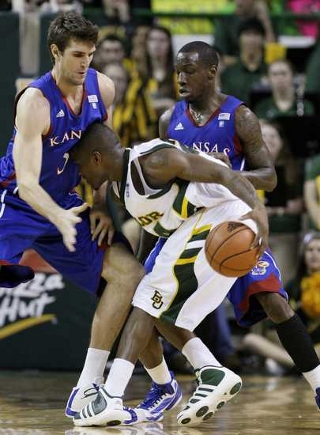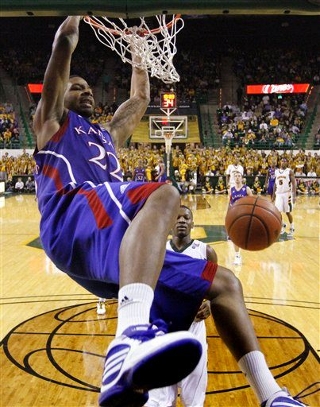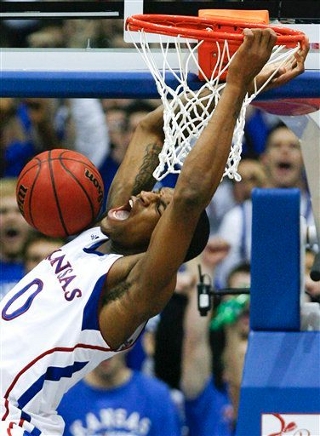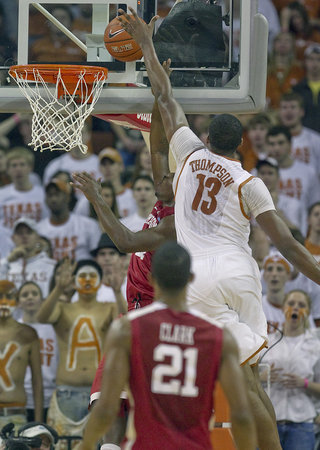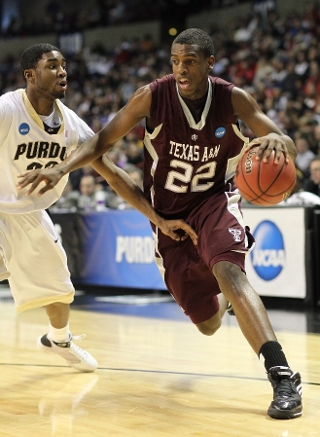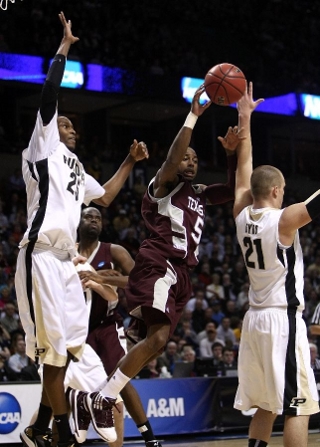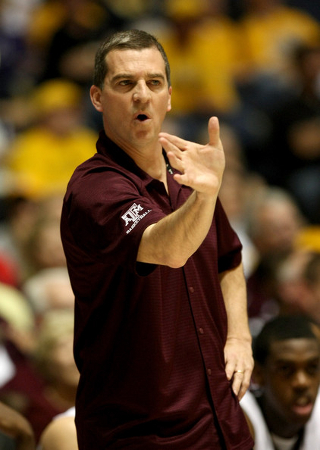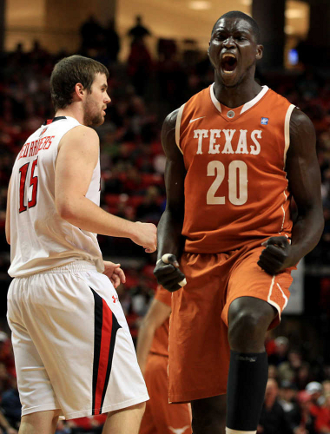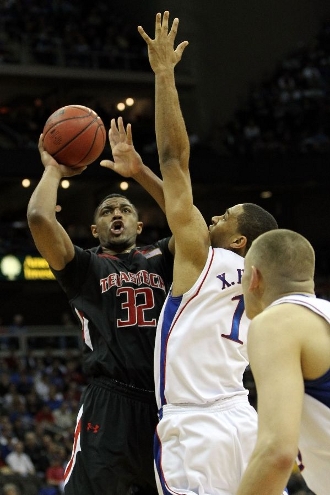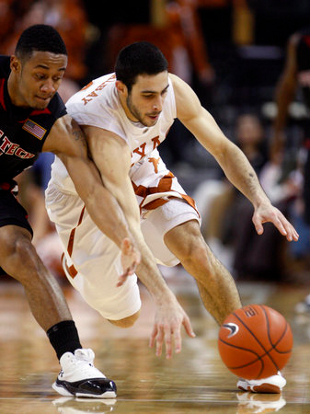Phog Allen Fieldhouse | Lawrence, KS | Tip: 3 P.M. CT | TV: CBS It would be a bit of an understatement to say that Allen Fieldhouse is a tough place for road teams to win. Just ask the last 69 teams that have come into the historic building, all of which left with a loss. The home-court advantage is so strong in Lawrence, in fact, that the second-longest active home winning streak in the country isn’t even half as long as the one the Jayhawks enjoy. The Duke Blue Devils — a dominant home team in their own right — have just a measly 30 consecutive wins at Cameron Indoor Arena. It could go without saying, then, that the Longhorns enter today’s big game as underdogs. Texas is 0-9 all-time in Lawrence, a streak that dates back to 1941. Break that curse, however, and the Longhorns will be sitting atop the league standings as the lone undefeated squad left in the Big 12.
Teams have had a tough time against the Jayhawk D The odds are long, but there is certainly a chance it could happen. Kansas has played a handful of close games this season, including three home contests that came down to the final minute. None of the visitors could overcome the Phog in the end, but UCLA, USC, and Nebraska all made valiant efforts. For such a talented, athletic team, the Jayhawks have seemed, at times, to have chinks in the armor. By the numbers The Jayhawks are so difficult to beat namely because they are incredibly efficient on both ends of the court. Their offense scores at a clip of 1.182 points per possession, which adds up quickly at Kansas’ brisk pace of 71.4 possessions per game. Bill Self’s team is highly efficient with the basketball because they refuse to take bad shots. They are constantly pushing the ball in transition, resulting in a ton of easy fast break buckets or good looks on the secondary break. When the open shot isn’t there, the Jayhawks are disciplined enough to pull the ball out and set up the offense. In the half-court, they move the basketball well, and are patient enough to wait for the right shot. That commitment to passing and good shot selction shows in the mountains of assists the Jayhawks pile up night after night. They have assists on more than 60% of their buckets, a number that ranks the team 34th in the country. If you could remove the team’s numerous fast-break layups that don’t require any passes, that percentage would climb even higher. In terms of adjusted tempo-free numbers, Kansas has the best defense in the country. They allow opponents to score just 0.829 points per possession, a number built upon the stingiest perimeter defense in the nation. Kansas opponents are shooting just 25.6% from behind the arc. The Jayhawks are also doing a great job forcing turnovers, causing miscues on 23.5% of opponents’ possessions. This will be an interesting stat to track this afternoon, as the Longhorns are one of the most disciplined teams in the country when it comes to controlling the basketball. Texas is coughing it up on just 17.1% of their possessions, good enough for 19th-best in the land. The starting five
Marcus Morris is playing like an All-American Kansas is led by their twin brothers from Philadelphia, Marcus and Markieff Morris. Marcus is the leading scorer for the Jayhawks, putting in more than 17 points per night. As Luke Winn wrote in this week’s Power Rankings, Marcus is also the nation’s most efficient scorer in post-up situations. What makes things even more difficult for Jayhawk opponents is that the big man can also step out and knock down jumpers from just about anywhere on the floor. Markieff, meanwhile, is much more of a low-post player. He’s certainly capable of scoring from outside — he’s shooting 33.3% from behind the arc — but he’s most useful to the Jayhawks when he’s positioned down low, cleaning up the glass. Markieff is averaging 8.7 boards per game, and his rebounding percentages are dominant on both ends of the court. On the offensive glass, he swipes 12.9% of the opportunities, good for 133rd in the nation. Defensively, he keeps opponents from getting second chances by grabbing 27.2% of the team’s rebounding opportunities. That impressive percentage is actually 14th-best in all of D-I basketball. In addition to the Brothers Morris, the most well-known name on the Jayhawk roster is freshman superstar Josh Selby. After sitting out the first nine games of the year as a result of accepting impermissible benefits, Selby made an immediate impact in his debut game, sinking the game-winning three against USC on December 18th. Since then, Selby has established himself as the team’s primary backcourt scoring threat, putting in more than 12 points a game. He’s absolutely deadly from long range, where he’s hit more than 42% of his attempts, and he simply knows how to create looks for himeself and his teammates. While he’s turned it over more times than he’s logged an assist so far this season, Selby’s ability to create with the basketball fits perfectly into KU’s crisp passing attack. Joining Selby in the backcourt are senior Tyrel Reed and junior Tyshawn Taylor. While Reed is a spot-up shooter who has made 37.4% of his threes so far, Taylor is a slashing threat that can get to the rim in a moment’s notice. While Taylor is probably known more for his off-court incidents with Facebook and the school’s football team, his skills on the court are nothing to be ignored. His quick moves with the ball force defenses to help and rotate, and it leads to a ton of assists to wide-open teammates. Taylor’s length also makes him an excellent defender on the perimeter. Off the bench With Kansas running up and down the floor, the Jayhawks have to utilize a bench that is ten or eleven men deep on any given night. Fortunately for Coach Self, the first five guys on the Kansas bench could probably comprise a starting five at many other schools. As Luke Winn illustrated in his January 13th Power Rankings, the Jayhawk bench actually posts Player Efficiency Ratings that are higher than some of the team’s starters.
Thomas Robinson brings a ton of energy from the bench Thomas Robinson is the big man of the future for Kansas, but he’s already doing a heck of a job as a sophomore. In just 15 minutes per game, he’s grabbing more than six boards. If he played enough minutes, Robinson’s 20.6% offensive rebounding percentage would actually be third in the nation. While Coach Self has compared Robinson to Dennis Rodman thanks to his uncanny knack to grab boards, he’s also a high-motor guy who runs the floor well in transition and provides an imposing defensive presence inside. On a team that doesn’t block shots like the Cole Aldrich-led squads, Robinson’s 7% block rate is a huge boost. Since arriving in Lawrence, juco transfer Mario Little has had a more convoluted storyline than a telenovela character. In his first season with Kansas, he missed much of the year with an injury, but chose to forgo a medical redshirt and rejoined the team in conference play. Last year, he did burn the redshirt thanks to Xavier Henry’s stranglehold on playing time, but then missed significant time this season after a December arrest for battery, criminal damage, and trespassing. When Little is actually on the court, however, he provides a great mismatch for Coach Self and the Jayhawks. He can be used as an oversized guard or an undersized forward, and he excels in both roles. He can knock down the long-range and mid-range jumpers, and can scrap inside for points and boards against much bigger players. Travis Releford is another tough match-up coming off the bench for the Jayhawks. At 6’5″, he’s taller than most guards, and it’s allowed him to can 46% of his threes so far this season. As pointed out in Winn’s column, Releford is incredibly efficient when he is on the court, and his 124.3 offensive rating puts him among the top 90 players in the country. Also in the backcourt, senior Brady Morningstar will provide key minutes from the bench. He’s a lockdown defender who also provides a steady hand on the offensive end. Sophomore Elijah Johnson is another guard option for Coach Self, and he’s even more reliable with the ball than Morningstar. Johnson, who was a five-star point guard prospect out of Las Vegas, has an assist-to-turnover ratio of 2.75-to-1. Seven-footer Jeff Withey could also see a little action in this one, but is averaging just 7.5 minutes and 2.8 boards per game so far this season. Keys to the game The number one thing Texas must do this afternoon is stop the basketball. Kansas is always looking up the court after they force opponents into missed shots, so the Longhorns can’t let the Jayhawks rack up easy points on fast breaks and secondary breaks. It’s no secret that Texas has had some defensive lapses this season where no one stops the ball, and it resulted in far too many easy buckets. That simply cannot happen if the team has designs on a huge road upset this afternoon. Texas also will need to dictate the tempo in this one. While the Longhorns have looked good when they are pushing the basketball, they don’t have the horses to compete in a sprinting match with Kansas. The Jayhawks run nine or ten deep on any given night, and the talent coming off their bench is significantly better than the reserves on Texas’ bench.
Texas will need another solid defensive effort today It’s also worth nothing that stat guru Ken Pomeroy has calculated a correlation coefficient of -0.33 between tempo and Texas’ offensive efficiency. To put that in layman’s terms, it means that while the direct link between tempo and offensive efficiency isn’t incredibly strong, it does indicate that the Longhorns benefit slightly from slowing the game down. Combined with the depth issues we just touched upon, these numbers indicate that the Horns need to control the pace this afternoon. Thanks to those depth issues, the Texas frontcourt must avoid foul trouble. While Alexis Wangmene had a quality game against A&M on Wednesday night, the Longhorns are going to need some serious minutes from Gary Johnson and Tristan Thompson this afternoon. If they pick up cheap ones early and force Wangmene or Matt Hill to have to defend the Morris twins for an extended period of time, things will likely not end well for Texas. Finally, the Longhorn defense must stay home. The quick Kansas ball movement means that any overpursuit or unnecessary gambles will immediately result in open looks. The Jayhawks are very fond of a high-low game that sets up the Morris brothers on the blocks, but if Texas tries to front those passes, it opens up the easy lob. Try to jump passing lanes on the perimeter, and the Jayhawks will nail a wide-open three. If Texas plays sound, vanilla defense, they can limit the number of easy looks Kansas will find this afternoon. |








